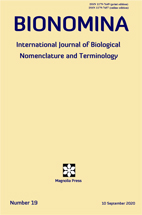Abstract
The nomen ‘Ptyas carinata (Günther, 1858)’, applied since 1864 to a large colubrid snake species of the Oriental region first reported from Borneo, is shown to be in fact an invalid junior objective synonym of Ptyas dhumnades (Cantor, 1842), a species of the same genus inhabiting China, Laos and Vietnam. In order to preserve the use of the well-known combination Ptyas carinata for the former species, Article 23.9 on reversal of precedence is used to validate Zaocys carinata Günther, 1864 against its senior secondary homonym Coryphodon carinatus Günther, 1858.
References
Anonymous [International Commission on Zoological Nomenclature] (1999) International code of zoological nomenclature. ‘Fourth edition’. London (International Trust for zoological Nomenclature): i–xxix + 1–306.
Blyth, E. (1854) Notices and descriptions of various Reptiles, new or little known. Journal of the Asiatic Society of Bengal (Natural History), 23 (3): 287–302.
Boettger, O. (1887) Herpetologische Notizen. I. Listen von Reptilien und Batrachiern aus Niederländisch Indien und von der Insel Salanga. Bericht der Senckenbergischen Naturforschenden Gesellschaft in Frankfurt am Main, 1887: 38–51.
Boulenger, G. A. (1893) Catalogue of the snakes in the British Museum (Natural History). Volume 1, containing the families Typhlopidae, Glauconiidae, Boidae, Ilysiidae, Uropeltidae, Xenopeltidae and Colubridae aglyphae, part. London (British Museum): i–xiv + 1–448, 28 pl.
Cantor, T. (1842) General features of Chusan, with remarks on the flora and fauna of that island. Animals observed at Chusan. Annals and Magazine of natural History, 9 (60): 481–493.
Cope, E. D. (1861) Catalogue of the Colubridae in the Museum of the Academy of Natural Sciences of Philadelphia. Part 3. Proceedings of the Academy of natural Sciences of Philadelphia, ‘1860’, 12 (12): 553–566.
David, P. & Das, I. (2004) On the grammar of the gender of Ptyas Fitzinger, 1843 (Serpentes, Colubridae). Hamadryad, 28 (1–2): 113–116.
Dubois, A. (1982) Notes sur les Grenouilles brunes (groupe de Rana temporaria Linné, 1758). I. Introduction. Alytes, 1 (4): 56–70.
Dubois, A. (1995) The valid scientific name of the Italian treefrog, with comments on the status of some early scientific names of Amphibia Anura, and some articles of the Code concerning secondary homonyms. Dumerilia, 2: 55–71.
Dubois, A. (2000) Synonymies and related lists in zoology: general proposals, with examples in herpetology. Dumerilia, 4 (2): 33–98.
Dubois, A. (2004) Book review. Amphibians of Nepal: a few words of caution. Alytes, 21 (3–4): 174–180.
Dubois, A. & Aescht, E. (ed.) (2019) LZC Session 24. Subtlelties of homonymy in zoological nomenclature. Dumerilia, 8: 66–84.
Dubois, A., Bauer, A. M., Ceríaco, L. M. P., Dusoulier, F., Frétey, T., Löbl, I., Lorvelec, O., Ohler, A., Stopiglia, R. & Aescht, E. (2019) The Linz Zoocode project: a set of new proposals regarding the terminology, the Principles and Rules of zoological nomenclature. First report of activities (2014‒2019). Bionomina, 17: 1‒111. < https://doi.org/10.11646/bionomina.17.1.1>.
Duméril, A.-M.-C., Bibron, G. & Duméril, A. (1854) Erpétologie générale ou histoire naturelle complète des Reptiles. Tome 7, première partie. Paris (Roret): i–vii + [i–iv] + i–xvi + 1–780.
Günther, A. C. L. G. (1858) Catalogue of colubrine snakes in the collection of the British Museum. London (British Museum [Natural History]): i‒xvi + 1‒281.
Günther, A. C. L. G. (1864) The Reptiles of British India. London (Ray Society): i‒xxvii + 1‒452, 28 pl.
Hu, B. Q., Huang, M. H., Xie, Z. T., Zhao, E. M., Jiang, Y. M., Huang, Q. Y., Zong, Y. & Ma, J. F (1980) Iconography of Chinese snakes. Shanghai (Shanghai Sciences & Technology Press): [i–iii] + 1–5 + 1–3 + 1–167, pl. 1–112. [In Chinese].
Maki, M. (1931) A monograph of the snakes in Japan. Tokyo (Dai-Ichi Shobo): 1–7 + 1–240 + Errata. [In English; reprinted in 1978].
Maki, M. (1931–1933). A monograph of the snakes in Japan. Tokyo (Dai-Ichi Shobo): 1–248. [In Japanese; reprinted in 1978].
Mell, R. (1931) List of Chinese snakes. Lingnan Science Journal, Canton, ‘1929’, 8: 199‒219.
Nguyen, V. S., Ho, T.C. & Nguyen, Q. T. (2009) Herpetofauna of Vietnam. Frankfurt-am-Main (Chimaira): 1‒768, 637 pl.
Pope, C. H. (1928) Four new snakes and a new lizard from South China. American Museum Novitates, 325: 1‒4.
Pope, C. H. (1935) The reptiles of China. Turtles, crocodilians, snakes, lizards. Natural History of Central Asia, New York (American Museum of Natural History), 10: i–xlii + 1–604, pl. 1–27.
Schleich, H. H. & Kästle, W. (ed.) (2002) Amphibians and Reptiles of Nepal. Koenigstein (A. R. G. Gantner Verlag Kommanditgesellschaft): [i‒ii] + i‒x + 1‒1201.
Sclater, W. L. (1891a) Notes on the collection of snakes in the Indian Museum with descriptions of several new species. Journal of the Asiatic Society of Bengal (Natural History), 60 (3): 230–250, pl. 6.
Sclater, W. L. (1891b) List of snakes in the Indian Museum. Calcutta (Indian Museum): i–x + 1–79. < https://doi.org/10.5962/bhl.title.8746>.
Stejneger, L. (1925) Chinese amphibians and reptiles in the United States National Museum. Proceedings of the United States national Museum, 66 (25): 1–115. < https://doi.org/10.5479/si.00963801.66-2562.1>.
Thireau, M. (1973) Observations écologiques sur une récolte de Batraciens dans les Pyrénées centrales. Bulletin de la Société d’Histoire naturelle de Toulouse, 109: 145‒149.
Wall, F. (1923) A hand-list of the snakes of the Indian Empire. Part 2. Journal of the Bombay natural History Society, 29 (3): 598–632.
Wallach, V., Williams, K. L. & Boundy, J. (2014) Snakes of the world. A catalogue of living and extinct species. London & New York (CRC Press): i–xxvii + 1–1209. < https://doi.org/10.1201/b16901-2>.

